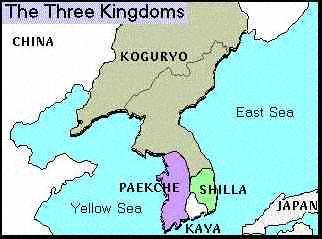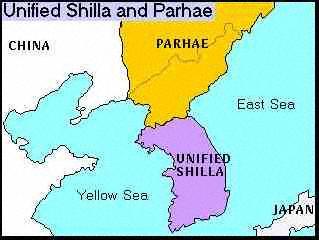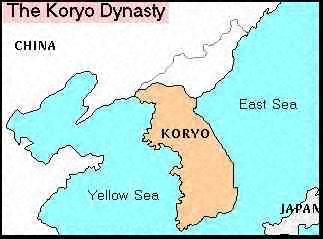|
| Korea Map 1 | |
|
| Korea: Unification
[For alternate depictions of Three Kingdoms Korea, see Map 2 and Map 3]. China at this time was divided into northern and southern sovereignties. Whereas Koguryo had continuing land contacts with north China, Paekche was in touch by sea with the southern Chinese states, from which Buddhism was introduced in 384. Silla came under Chinese influence also, and in 503 adopted the Chinese title wang "king" for its ruler. A Chinese style lawcode was created shortly afterward, and Buddhism was adopted in 528. Silla and Paekche between them eliminated the Japanese enclave of Kaya by 562. China was reunified [under the brief Swei dynasty] in 589, and immediately attempted to reassert control over Korea. Koguryo repulsed a large-scale attack in 592, and later attacks on an even larger scale in 612-614 failed so badly as to hasten the end of the Swei. The ensuing Tang dynasty launched attacks in 644, 646, 658, and 659, which also failed. Finally a Chinese naval assault on Paekche in 660, together with cooperation from Silla on the east, succeeded in destroying Paekche. A joint Tang/Silla campaign subjugated Koguryo. Control of the resulting unified peninsula was then disputed between Tang China and Silla, with the result that Tang China finally recognized Silla in the south, and Parhae (Ch Pwohai, the Korugyo remnant plus neighboring Tungusic peoples, founded in 713) in the north, as "tributary" but independent states:
Silla prospered, and became extensively Sinicized, in parallel with Tang China. It weakened as Tang China weakened. The Silla elite became ineffective, and there were several revolts in the 770's, followed by the killing of the Silla king in 780. This inaugurated a long period of rival ruling lineages and constant coups and assassinations. Banditry increased among the lower population. Commerce expanded in this time of state breakdown, and Korean merchants established communities in northeast China. Peasant uprisings had broken out by 889, and over the next decades several attempts were made to found new states. In 918 the state of Koryo (shortened from the old name Koguryo) was established, and soon was able to force the submission of the Silla ruler in 935. It conquered its last rival, the Later Paekche state, in 936. Thus began the Koryo dynasty, whose span was 918-1392:
All
lectures and abstracts posted on this site are Copyright ©
by their authors. 19 Apr 2002 / Contact The Project / Conferences Page |


